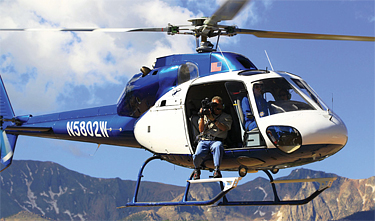Canon Lens Smooths Out Pikes Peak Race

The Canon HJ15 image-stabilized lens made it possible for Sam Allen to capture great HD, even in turbulent air. ©Kevin Kozlowski
DENVER
The annual Pikes Peak International Hill Climb in June provided a demanding and unique production challenge. I shot HD video of this 88th running of the internationally famous 12.42-mile race from the open door of an AirCam Aerospatiale Twinstar AS355 F1 helicopter. Flying can get very tricky up here in the mountains, especially when you're operating between 10,000 and 14,000 feet. We had wind and downdrafts, which made for one of the roughest days I've ever had on that mountain.
Fortunately, I'd attended a post-NAB Show open house at Telecorps Sales and Leasing at the Denver Tech Center several weeks earlier and had the opportunity to see the new Canon HJ15ex8.5B portable HD zoom lens. This is the world's first such lens with built-in optical image stabilization. It's compact in size and weighs in at only 4.4 pounds. The new HJ15 lens was specially designed to maintain stable images, even when the camera that it's being used with is subjected to jolts and vibrations. The HJ15 uses a new version of Canon's patented Vari-Angle Prism Image-Stabilizer technology to achieve a high level of steadiness throughout its range—all the way from wide-angle to telephoto settings.
STABILIZATION IS A MUST IN HIGH DEFINITION
I used the Canon HJ15 lens on a Sony PDW-F800 XDCAM optical disc HD camcorder, and was very impressed by how well the lens responded to the vibration the package was getting from the helicopter. High definition's greater picture resolution always picks up more of everything, and this includes camera vibrations. With the HJ15, however, there was no vibration observable on the video recorded.
The difference between Canon's new HJ15 lens and an older standard-definition image-stabilizer lens that I've used was like the difference between night and day. The older stabilized SD lens produced a visible lag in the images being captured. This was certainly not the case with the HJ15. When you turn the camera left or right, the image goes left or right without any delay or loss of image.
The operating controls and buttons on the new HJ15 lens are also easy for the camera operator to access. If you're not used to a particular lens, you might not remember to hit the right button to turn the image stabilization feature on or off. However, the control on this new Canon is mounted out in front. This design really makes it very difficult to accidentally turn the image stabilization off.
The Canon HJ15 image stabilized lens is also a very clean and sharp optic that responds well and does just what it is supposed to do. Having it to shoot the Pikes Peak International Hill Climb in high definition from a helicopter being buffeted by all sorts of wind velocities was tremendous. I really have to thank Canon for developing this lens, because if it weren't for their people designing optics like this we would all still be back in the 1960s, operating with that era's greatly limited lens technology.
Sam Allen has been shooting a wide range of film and video formats for the past 25 years. He may be contacted atsam@samallenproductions.com.
For additional information, contact Canon at 800-321-4388 or visitwww.canonbroadcast.com.
The professional video industry's #1 source for news, trends and product and tech information. Sign up below.
